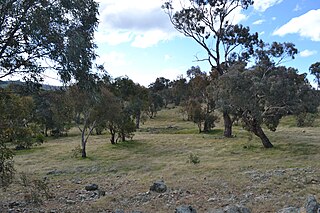
Lichenology is the branch of mycology that studies the lichens, symbiotic organisms made up of an intimate symbiotic association of a microscopic alga with a filamentous fungus. Lichens are chiefly characterized by this symbiosis.

Cladonia is a genus of moss-like lichenized fungi in the family Cladoniaceae. They are the primary food source for reindeer/caribou. Cladonia species are of economic importance to reindeer-herders, such as the Sami in Scandinavia or the Nenets in Russia. Antibiotic compounds are extracted from some species to create antibiotic cream. The light green species Cladonia stellaris is used in flower decorations.

The Cladoniaceae are a family of lichen-forming fungi in the order Lecanorales, comprising about 560 species distributed amongst 18 genera. This family is one of the largest among lichen-forming fungi and is globally distributed, from Arctic tundra to tropical rainforests, favouring humid environments while being intolerant of arid conditions. Molecular phylogenetics has significantly advanced the understanding of their complex taxonomic history, revealing intricate evolutionary relationships and leading to a refined classification. Notable members include reindeer moss and cup lichens of the genus Cladonia, which consist of about 500 species and forms a significant part of the diet for large mammals in taiga and tundra ecosystems.

Peltigera is a genus of approximately 100 species of foliose lichens in the family Peltigeraceae. Commonly known as the dog or pelt lichens, species of Peltigera are often terricolous, but can also occur on moss, trees, rocks, and many other substrates in many parts of the world.

The Flora of the Australian Capital Territory are the plants that grow naturally in the Australian Capital Territory (ACT). The environments range from Alpine area on the higher mountains, sclerophyll forest, to woodland. Much of the ACT has been cleared for grazing, and is also burnt off by bushfires several times per century. The kinds of plants can be grouped into vascular plants that include gymnosperms, flowering plants, and ferns; bryophytes, lichens, fungi, and freshwater algae. Four flowering plants are endemic to the ACT. Also several lichens are unique to the ACT, however as further study is undertaken they are likely to be found elsewhere too.

Cetraria is a genus of fruticose lichens that associate with green algae as photobionts. Most species are found at high latitudes, occurring on sand or heath, and are characterised by their "strap-like" form with spiny lobe edges. The lobes can range from narrow and linear to broader and flattened, often forming loose or densely packed cushions. Their distinctive spiny margins serve both a defensive role and aid in vegetative reproduction through fragmentation. The genus was created by Erik Acharius in 1803 and belongs to the large family Parmeliaceae. While originally a species-rich genus, taxonomic revisions since the 1960s have split many species into new genera, though the exact circumscription remains debated among lichenologists.
Vernon Ahmadjian was a distinguished professor at Clark University in Worcester, Massachusetts. He specialized in the symbiosis of lichens, and wrote several books and numerous publications on the subject.

The Botany of Lord Auckland's Group and Campbell's Island is a description of the plants discovered in those islands during the Ross expedition written by Joseph Dalton Hooker and published by Reeve Brothers in London between 1844 and 1845. Hooker sailed on HMS Erebus as assistant surgeon. It was the first in a series of four Floras in the Flora Antarctica, the others being the Botany of Fuegia, the Falklands, Kerguelen's Land, Etc. (1845–1847), the Flora Novae-Zelandiae (1851–1853), and the Flora Tasmaniae (1853–1859). They were "splendidly" illustrated by Walter Hood Fitch.

Cladonia rei, commonly known as the wand lichen, is a species of ground-dwelling, fruticose lichen in the family Cladoniaceae. It is a widely distributed species, having been reported from Africa, Asia, Australasia, Europe, and North America. It is identified by its slightly dirty-colored, rough-surfaced, slender podetia that grow up to 9 cm (3.5 in) tall. Diagnostic characters of the lichen include the continuously sorediate, green-and-brown-mottled, podetia that taper upward to a point, while chemically, it contains homosekikaic and sekikaic acids. Its reduced capacity to bioaccumulate toxic heavy metals from its surroundings, as well as its ability to switch photobiont partners, allows the lichen to colonize and survive highly polluted habitats. There are several other Cladonia species that are somewhat similar in appearance, but can be distinguished either by subtle differences in morphology, or by the secondary chemicals they contain.

Succinprotocetraric acid is an organic chemical compound with the formula C22H18O12. It is the ester of succinic acid and protocetraric acid and it is classified as a depsidone.

Cladonia grayi, commonly known as Gray's cup lichen or Gray's pixie cup, is a species of fruticose lichen in the family Cladoniaceae. It is characterised by small, leaf-like squamules forming its primary thallus and distinctive upright podetia that develop into goblet-shaped cups. The species contains several unique lichen substances, primarily grayanic acid, which causes it to glow light blue under ultraviolet light, and has also been found to produce protective pyrrolopyrazine compounds. Its photobiont is the green algal species Asterochloris glomerata.

Grayanic acid is an organic compound found in certain lichens, particularly Cladonia grayi, where it serves as a secondary metabolite with notable taxonomic importance. Identified in the 1930s, it is now recognised as a chemotaxonomic marker that helps distinguish closely related species within the Cladonia chlorophaea species group. Grayanic acid crystallises as colourless, needle-like structures, melts at approximately 186–189 °C (367–372 °F), and displays distinctive fluorescence under ultraviolet light, aiding in its detection and study.

Protocetraric acid is a chemical compound with the molecular formula C18H14O9. It is a secondary metabolite produced by a variety of lichens and is classified as a depsidone.












